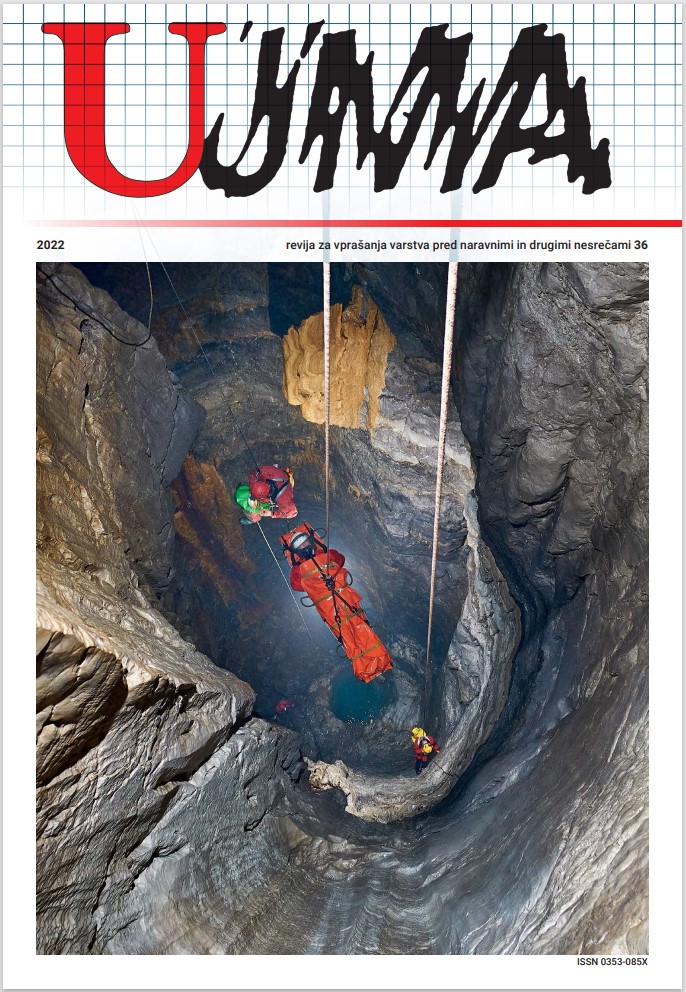KNOWLEDGE OF LIMB BANDAGING FOR THE MANAGEMENT OF MAJOR HAEMORRHAGE IN FIRST AID
Abstract
Severe bleeding is life-threatening and should be stopped immediately as part of first aid. One of the existing methods of stopping severe bleeding in the extremities is a limb bandage, also known as an Esmarch‘s tourniquet. The aim of this study was to determine the knowledge of the general public on the use of the limb bandage in first aid. An online questionnaire was completed by 190 people. About two thirds (67%) of the respondents would use an Esmarch‘s tourniquet if a pressure bandage failed to stop severe bleeding in an arm or leg, and the vast majority (92%) knew that a tourniquet should not be placed on the neck. More than half (56%) would apply a tourniquet in a case of a venomous snake bite, and 41% in a case of amputation of the fingers; both of these are not appropriate. Most respondents (84%) would use a triangular bandage to improvise a dressing. The knowledge of respondents on first aid for haemorrhage and the use of the Esmarch tourniquet was deficient and not up-to-date. This is about knowledge that can save lives. As recommendations on the use of a tourniquet to stop bleeding in first aid have changed in recent years, the general public should be informed about the current guidelines.
References
Ahčan, U., Špan, M., 2006. Krvavitev. V: Ahčan, U. (urednik), Prva pomoč: priročnik s praktičnimi primeri, 1. izd., Ljubljana: Rdeči križ Slovenije, 97–116.
Davids, N. B., Mabry, R. L., 2015. Hemorrhage control. V: Cone, D. C., Brice, J. H., Delbridge, T. R., Myers, J. B. (uredniki), Emerg Med Services: clinical practice and systems oversight, 2 Volume Set, 265–271. doi: 10.1002/9781118990810.ch35.
Deakin, C. D., Nolan, J. P., Soar, J., in sod., 2010. European resuscitation council guidelines for resuscitation 2010. Section 4. Adult advanced life support. Resusc, 81(10), 1305–1352. doi: 10.1016/j.resuscitation.2010.08.017.
Dennis, A., Bajani, F., Schlanser, V., in sod., 2019. Missing expectations: windlass tourniquet use without formal training yields poor results. J Trauma Acute Care Surg, 87(5), 1096–1103. doi: 10.1097/TA.0000000000002431.
Fuchs, S., 2020. Tourniquets in major extremity trauma. Pediatr Emerg Care, 36(10), 489–494. doi: 10.1097/PEC.0000000000002226.
Galante, J. M., 2017. Using tourniquets to stop bleeding. Jama, 317(14), 1490. doi: 10.1001/jama.2015.8581.
Gargi, G., Saini, A., 2020. Tourniquet application in snake bite: are we aweare? Int J Res Med Sci, 8(8), 3031–3034. doi: 10.18203/2320-6012.ijrms20203459.
Godpower, C. M., Thacher, T. D., Shehu, M. I. L., 2011. The effect of pre-hospital care for venomous snake bite on outcome in Nigeria. Trans R Soc Trop Med Hyg, 105(2), 95–101. doi: 10.1016/j.trstmh.2010.09.005.
Gradišek, P., Grošelj Grenc, M., Strdin Košir, A. (uredniki), 2015. Smernice za oživljanje 2015 evropskega reanimacijskega sveta. Ljubljana: Slovensko združenje za urgentno medicino, 110–113.
https://www.szum.si/media/uploads/files/ERC_2015_slo-1.pdf, 2. 6. 2021.
Gradišek, P., Grošelj Grenc, M., Strdin Košir, A. (uredniki), 2021. Smernice evropskega reanimacijskega sveta za oživljanje 2021. Ljubljana: Slovensko združenje za urgentno medicino, 53–57. https://www.szum.si/media/uploads/files/Smernice_2021.pdf, 12. 5. 2022.
Hernigou, P., 2016. Authorities and foundation of an orthopaedic school in Germany in the nineteenth century: Part I: Conrad Johann Martin Langenbeck; Georg Friedrich Louis Stromeyer; Bernhard Rudolf Conrad von Langenbeck; Johann Friedrich August von Esmarch. Int J Orthop, 40(3), 633–640. doi: 10.1007/s00264-015-3009-y.
IFRC – International Federation of Red Cross and Red Crescent Societies, 2020. International first aid, resuscitation and education guidelines 2020. https://www.ifrc.org/document/international-firstaid-resuscitation-and-education-guidelines, 5. 5. 2022.
Kragh, J. F., 2011. Tourniquets. V: Owens, B. D., Belmont, P. J. (urednika), Combat orthopedic surgery: lessons learned in Iraq and Afghanistan, Slack Incorporated, 119–26. http://104.131.4.44/images/uploads/2015/11/027-tourniquets-2011.pdf, 31. 8. 2021.
Loftus, A., Pynn, H., Parker, P., 2018. Improvised first aid techniques for terrorist attacks. Emerg Med J, 35(8), 516–521. doi: 10.1136/emermed-2018-207480.
Mahmood, M. A., Halliday, D., Cumming, R., in sod., 2019. Inadequate knowledge about snakebite envenoming symptoms and application of harmful first aid methods in the community in high snakebite incidence areas of Myanmar. PLoS Negl Trop Dis, 13(2), 1–10. doi: 10.1371/journal.pntd.0007171.
McMillan, T. E., Gardner, T., Johnstone, A. J., 2020. Current concepts in tourniquet uses. Surgery. doi: 10.1016/j.mpsur.2020.01.005.
Pasley, A. M., Parker, B. M., Levy, M. J., in sod., 2018. Stop the bleed: does the training work one month out? Am Surg, 84(10), 1635–1638. doi: 10.1177/000313481808401020.
Pellegrino, J. L., Charlton, N., Goolsby, C., 2020. »Stop the Bleed« Education Assessment Tool (SBEAT): Development and Validation. Cureus, 12(9), e10567. doi 10.7759/cureus.10567.
Shackelford, S. A., Butler, F. K., Kragh, J. F., in sod., 2015. Optimizing the use of limb tourniquets in tactical combat casualty care. J Spec Oper Med, 15(1), 17–31. https://www.researchgate.net/publication/273577952_Optimizing_the_Use_of_Limb_Tourniquets_in_Tactical_Combat_Casualty_Care_TCCC_Guidelines_Change_14-02, 10. 8. 2021.
Slabe, D., Jerman, A., Dolenc, E., Brvar, M., 2019. Poznavanje napotkov za prvo pomoč v primeru ugriza kače – poročilo o raziskavi. Ujma, 33, 230–236.
Smith, L. A., Caughey, S., Liu, S., in sod., 2019. World trauma education: hemorrhage control training for healthcare providers in India. Trauma Surg Acute Care Open, 4(1), 1–3. doi: 10.1136/tsaco-2018-000263.
Stewart, S. K., Duchese, J. C., Khan, M. A., 2015. Improvised tourniquets: Obsolete or obligatory? J Trauma Acute Care Sur, 78(1), 178–83. doi: 10.1097/TA.0000000000000485.
Welling, D. R., McKay, P. L., Rasmussen, T. E., Rich, N. M., 2012. A brief history of the tourniquet. J Vasc Surg, 55(1), 286–290. doi: 10.1016/j.jvs.2011.10.085.
Zagorac, N., 2015. Prebila ga medvjedica: »Popeo se na drvo, ali ga je slijedila...«. 24 sata. https://www.24ata.hr/news/prebila-ga-medvjedica-popeo-se-na-drvo-ali-ga-je-slijedila-443688,21. 6. 2022.
Zideman, D. A., De Buck, E. D. J., Singletary, E. M., in sod., 2015. European Resuscitation Council Guidelines for Resuscitation 2015 Section 9. First aid. Resuscitation, 95, 278–287. doi: 10.1016/j.resuscitation.2015.07.031.
Zwislewski, A., Nanassy, A. D., Meyer, L. K., in sod., 2019. Practice makes perfect: The impact of Stop the Bleed training on hemorrhage control knowledge, wound packing, and tourniquet application in the workplace. Injury, 50(4), 864–868. doi: 10.1016/j.injury.2019.03.025.
Downloads
Published
Issue
Section
License

This work is licensed under a Creative Commons Attribution-NonCommercial-NoDerivatives 4.0 International License.
The articles are made available to the public under Creative Commons Attribution-NonCommercial-NoDerivatives 4.0 International (CC BY-NC-ND 4.0).


